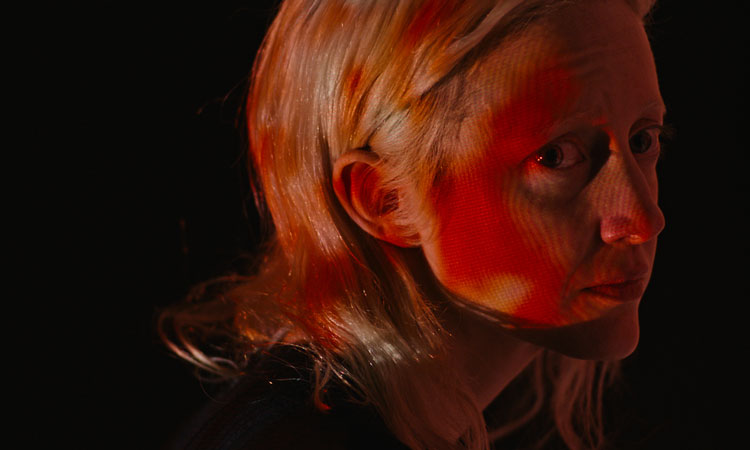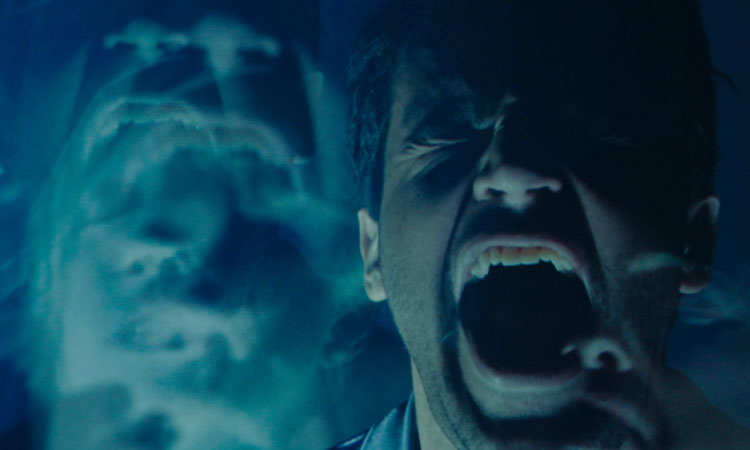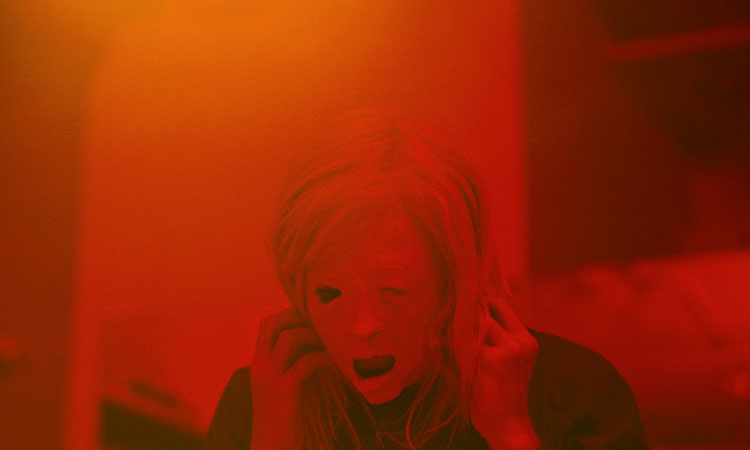Possessor follows the elite, corporate assassin Tasya Vos (Andrea Riseborough, Mandy) who uses brain-implant technology to take control of other people’s bodies to execute high profile targets. However, as she sinks deeper into her latest assignment with Colin Tate (Christopher Abbott), Vos becomes trapped inside a mind that threatens to obliterate her.
Written and directed by Brandon Cronenberg, Possessor is a visual spectacle with complex characters and frighteningly believable and devastating technology. We spoke to Brandon about creating those visuals and what he has in common with Vos…
When did the idea of Possessor first come to you?
It was during the process of going through my first film press tour actually, which was is totally trivial. Of having that strange experience of building a public persona or suddenly living a very different kind of life, and in my personal life for other reasons. I was feeling as though I couldn’t see myself in my own life. I was getting up in the mornings feeling as though I were getting up into someone else’s life and having to scramble to create a character who could operate in that context.
I wanted to initially write a film about someone who may or may not be an impostor in their own life as a way of discussing how we build characters and narratives in order to function as human beings in a basic way. Because I think that kind of storytelling is just inherent to how we operate.
The science fiction, thriller and horror elements actually grew out of that initial idea, but it was more of the quieter dramatic scenes that were the seed level.
How do you go about creating such complex characters?
They are, in some ways, amalgamations of people I know. I don’t know anybody who’s a body swap assassin [haha] but I honestly just feel them out. There’s an initial arc from a story perspective that I think they need to take, but then in a scene-by-scene way, I like to let them speak and let them guide the action to a certain degree as I’m writing.
What were your thoughts and inspirations behind the character of Tasya Vos?
Again, it was in a scene-by-scene away. In an early version of the film, an outline that I did for her was actually male because I had come up with the idea just through my own personal experiences being on the road with the film and of creating a public persona. [It] was very strange seeing videos of myself online performing another version of myself for interviews. It was completely surreal so I guess I defaulted to a male character who is somewhat like me. But then I thought that was boring for a number of reasons. I had already done a male character for [my previous film] Antiviral, plus I think we’ve all seen so many films where this husband and father is unable to relate to his family because of the horrors of his job. You know whether it’s The Hurt Locker or any of these kinds of police films, so I thought it would be more interesting to have a woman.

She isn’t given much of a backstory, did you write one for her?
There were a few more details, but I don’t want to tell you what they are because she’s meant to be open. The film is designed in some ways to leave space for the audience to be creative. Although I had my own very specific ideas about the characters in the story, I like filmmaking where there’s room for interpretation and disagreement. I don’t want to preclude the possibility of people having those conversations and hopefully even disagreements by telling them what to think.
She’s an elite assassin but in her latest assignment, things go terribly wrong. What is it about this case that affects her so much?
Again, I don’t want to lean too hard into interpreting the film, but to me, it’s less just this case and more of a process that she’s been going through. Because you see her in the opening sequence also struggling for control and so this is a process of losing control.
What were your inspirations when creating the film?
I watch a bunch of movies and read a bunch of books as I’m working, and then I sort of mash them together into a kind of loaf that I just leave at the back of my head. There were some films that I watched with my team. We spent a lot of time looking at things from a filmmaking perspective, less in the writing process and more leading up to the shoot. For instance, we looked at opera a fair bit and some other films that were interesting to us from a technical and a visual perspective.
Possessor has a lot of unique visuals, how did you go about creating those?
I left it open to a process of experimentation. There were certain things that I knew, very specifically, I wanted in the film. For instance, in the scene where it flips to red on and off (which is the internal world versus the external world) – that was an image that I had specifically.
But I have a particular process that I go through with Karim Hussain, the cinematographer. We’re quite close friends and actually, we lived down the street from each other during the years of Possessor development. So we would spend a lot of time in his living room playing with various projection feedback and lenses and gels, and finding ways that we could distort the image. So in the script, there are these very short paragraphs that basically say ‘the image deforms into nightmarish flashes’ (everything goes crazy) and that’s a code for me, Kareem and Dan Martin the effects artist to treat that section almost like a music video or experimental video. Those stretches are entirely practical effects, there’s no CGI involved, so when you’re doing this kind of hands-on filmmaking, you discover all these happy accidents that take you down different visual paths and I like to leave it open to that process.

We particularly like the wax ‘melting’ effect when Tasya transcends from her body into Tate’s…
Using that kind of practical effect was something I’ve been interested in for a while and it seemed like a good excuse to play with that. I brought it up with Dan and he did some experiments with melting blocks and played it in reverse in order to melt and reform. These early experiments looked fantastic, so that was something we incorporated. He just made these fantastic wax figures that were incredibly well painted. They look almost like CGI sometimes because of the paint job, but they’re actually completely practical.
On the last day of shooting, the final thing that we did was melt all that stuff we had. We had three massive heat cannons and we were in a warehouse and we were just melting them very slowly. Half of the crew was fixated on the melting wax, the other half of the crew was watching the Toronto Raptors game because it was when the Raptors were in the finals, so you could really tell where people’s loyalties were!
The film has futuristic technology but there are a few elements that feel old. What time is Possessor set in?
In my mind, and I think it made it into the film as an Easter egg, it’s set in 2008 in Toronto, in an alternate timeline. The reason I did that was, although the technology could exist, and although I did a fair bit of research into neuroscience and found that that kind of physical brain control is possible to get to, it would have to be set in the very distant future.
We’re not near that point yet (even though there’s been some incredible interest – it was even done back in the Fifties and Sixties, with wires implanted for electrical stimulation of the human brain), so it would have to be a distant future film. But I didn’t really want to make predicted science fiction [film].
It wasn’t that technology was intended to show what the future will be. It was really intended as a metaphor to talk about how we function and talk about things that are going on now. I wanted the world to feel more familiar and more current, so I set it in an alternate timeline where that technology has advanced at a different pace and that freed me up to essentially do whatever I wanted with the world and then keep it natural.
Possessor’s ‘futuristic’ tech has an analog aesthetic to it. Why did you go down this visual route?
Part of it is just an aesthetic thing because there’s something very tactile about that, but it’s less exciting to me, visually, to see a lot of screens and touchpads. Also that’s been done in Black Mirror and a lot of other predictive science fiction that’s trying to imitate the real world. So in order to give it a different look and a different feel, I didn’t want to go in that direction.
Although actually when you look at a lot of the real-world equivalents, when you look at brain-machine interfaces, the technology does tend to be pretty analog because a lot of it’s in the prototype stage. A lot of the touchpads and the gloss come later when products are being made for consumer production, but a lot of the actual neuroscience that experiments are done with very are analog-looking!

Speaking of future technology – the company that Tate works for uses spy software (using webcams to look into people’s homes) for market research. Why did you include that element?
Well, maybe they do that right now, you know! It’s the entire business model for Google. A lot of these companies there’s this, on the one hand very alarming invasion of privacy or tracking of people’s actions on social media and using various apps, but a lot of it is just used to advertise to people and to track their buying habits. So that was an exaggerated version of what’s already happening.
But the surveillance element really entered into it because the Snowden leaks happened during the early stages of writing. So I was feeling very depressed about the death of privacy through technology and wanted to address that. So I think the zoom-through scenes with the webcams and the VR office all work as an on-the-nose satire of some of the stuff that’s happening right now.
But also, I think the surveillance angle can function metaphorically [when] looking at the body possession elements of the film. Instead of someone activating your microphone on your computer or your camera on your cellphone, they’re actually inside your body, experiencing the most intimate details of your life – first hand through your own nerve endings or [through] the body of someone close to you and that person is actually someone else. Some outsider who’s functioning as a kind of full-body organic surveillance device…
What is it about sci-fi that appeals to you?
I think that sci-fi is a fantastic way to discuss the real world because you take things, thematically, that are very real and relevant to people, but you caricature them. You send them in the [near] future to discuss where we’re going or you send them to an adjacent world to discuss where we are now.
Sci-fi really frees you up to talk about a lot of things and puts the audience in a place where they can examine the world from a fresh perspective…
Possessor is on digital platforms from 27 November.
